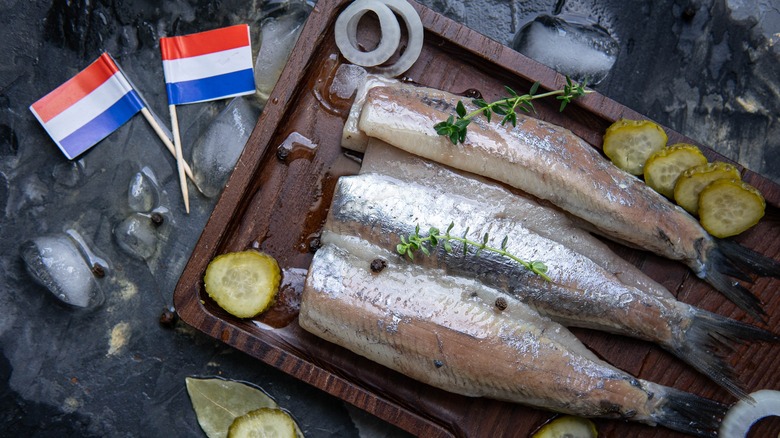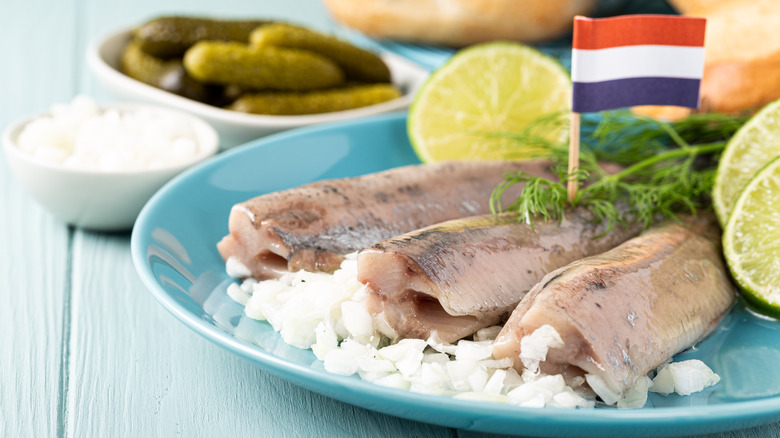Why Herring Is So Popular In The Netherlands During Lent
When February rolls around, Catholics worldwide start planning for Lent. This 40-day period symbolizes the time when Jesus Christ was believed to have gone into the desert to pray and fast before dying on the cross, and even if you're not Catholic, you've probably heard about this season. It's a time when people choose to give up something they love, like chocolate or television. In the Netherlands, where Catholicism is still the largest religious denomination, many people choose to go meatless, as meat has traditionally been considered a festive food. It's not so hard for the Dutch, however, because eating herring (who needs meat?) is a point of national pride.
If you're visiting the Netherlands during Lent, you'll likely come across some herring in the days leading up to Easter. Usually, the fish feasting happens on Ash Wednesday. The custom is to get an ash cross drawn on your forehead at church and then enjoy herring in celebration. While it's common to eat the fish lightly preserved and whole, you can still show your dedication to observing this time-honored tradition by eating herring that's been smoked, cooked, and even mixed into a creamy potato salad. As long as you're not eating meat, you're on the straight and narrow.
The Netherlands owes its history to herring
The history of the Netherlands and herring are practically inseparable. People from this region of the world have been eating the fish, which is native to the North Sea, for thousands of years. However, when commercial fishing became an industry, the country built a vast amount of wealth on the strength of its herring exports.
These days, herring is mainly fished in Scandinavia, as the trade was banned in the North Sea in 1977. But the Netherlands never gave up its love for the diminutive seafood. To this day, enthusiasts from the country continue to eat as much as 35 million herring a year, according to the Marine Stewardship Council. So when it comes time to give up meat for Lent, Catholics of the Netherlands don't have to look very far to find some herring. In fact, it has classically been one of the country's most popular street foods.
Herring is available year-round in the Netherlands. However, the best time to eat the fish fresh begins around late spring or early summer. So the rest of the year, including during Lent, people are typically eating herring that has been brined or cured with salt.
Eat herring like a pro
If you peruse the internet in search of herring-eating tips for your next trip to Holland, you'll learn that the local custom is to grab the entire fish by the tail and eat it whole. It typically has had its head, scales, and bones removed; then, it's frozen and lightly cured with salt for a few days. So, while it's technically not raw, it's also not like eating a piece of grilled fish. This style of eating herring is known as haringhappen, and it's mostly done when the new (young) herring season starts in the summer. People in the Netherlands also like to perform this ritual on holidays, especially on Ash Wednesday after Carnival is over.
That's not to say that all herring is eaten by the tail, however. If you're observing Lent and want to abstain from meat like the Dutch, but you're squeamish about downing a whole fish in one go, try making a creamed herring salad with the cured fish, some cooked potatoes, and maybe chopped eggs and beets to get your fix. It's also a lot easier to find pickled herring in the U.S. than it is to find fresh herring — just check out any gourmet food shop or wholesaler that carries tinned fish. With a little luck, you'll be able to observe Ash Wednesday or any day during Lent, like a true Dutch expat. Sadly, however, you'll still have to travel to Europe if you've got your heart set on a Lent-approved dessert burger.


